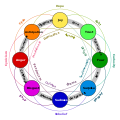
Back Liefde Afrikaans Liebe ALS ፍቅር Amharic Amor AN Lufu ANG حب Arabic حب ARY حب ARZ প্ৰেম Assamese Amor AST
| Part of a series on |
| Love |
|---|
| Part of a series on |
| Emotions |
|---|
  |
Love is a feeling of strong attraction and emotional attachment to a person, animal, or thing.[1] It is expressed in many forms, encompassing a range of strong and positive emotional and mental states, from the most sublime virtue or good habit, or the deepest interpersonal affection, to the simplest pleasure.[2] An example of this range of meanings is that the love of a mother differs from the love of a spouse, which differs from the love of food.
Love is considered to be both positive and negative, with its virtue representing kindness, compassion, and affection—"the unselfish, loyal, and benevolent concern for the good of another"—and its vice representing a moral flaw akin to vanity, selfishness, amour-propre, and egotism. It may also describe compassionate and affectionate actions towards other humans, oneself, or animals.[3] In its various forms, love acts as a major facilitator of interpersonal relationships, and owing to its central psychological importance, is one of the most common themes in the creative arts.[4][5] Love has been postulated to be a function that keeps human beings together against menaces and to facilitate the continuation of the species.[6]
Ancient Greek philosophers identified six forms of love: familial love (storge), friendly love or platonic love (philia), romantic love (eros), self-love (philautia), guest love (xenia), and divine or unconditional love (agape). Modern authors have distinguished further varieties of love: fatuous love, unrequited love, empty love, companionate love, consummate love, infatuated love (limerence), amour de soi, and courtly love. Numerous cultures have also distinguished Ren, Yuanfen, Mamihlapinatapai, Cafuné, Kama, Bhakti, Mettā, Ishq, Chesed, Amore, charity, Saudade (and other variants or symbioses of these states), as culturally unique words, definitions, or expressions of love in regard to specified "moments" currently lacking in the English language.[7]
The colour wheel theory of love defines three primary[i], three secondary[ii], and nine tertiary[iii] love styles, describing them in terms of the traditional color wheel.[8][9] The triangular theory of love suggests intimacy[iv], passion[v], and commitment[vi] are core components of love.[10] Love has additional religious or spiritual meaning. This diversity of uses and meanings, combined with the complexity of the feelings involved, makes love unusually difficult to consistently define, compared to other emotional states.
- ^
- Oxford Illustrated American Dictionary. Oxford University Press. 1998. p. 485.
- "Love Definition & Meaning". Merriam-Webster. 27 December 1987. Archived from the original on 17 May 2019. Retrieved 30 September 2021.
- "Love Definition & Meaning". YourDictionary. Archived from the original on 12 July 2022. Retrieved 12 July 2022.
- ^
- "Definition of love in English". Oxford English Dictionary. Archived from the original on 2 May 2018. Retrieved 1 May 2018.
- "Meaning of love in English". Cambridge English Dictionary. Archived from the original on 2 May 2018. Retrieved 1 May 2018.
- Karandashev, Victor (2017). Romantic Love in Cultural Contexts. Cham: Springer International Publishing. doi:10.1007/978-3-319-42683-9. ISBN 978-3-319-42681-5.[page needed]
- Hongladarom, Soraj; Joaquin, Jeremiah Joven, eds. (2021). Love and Friendship Across Cultures. Singapore: Springer Singapore. doi:10.1007/978-981-33-4834-9. ISBN 978-981-334-833-2. S2CID 243232407.[page needed]
- Treger, Stanislav; Sprecher, Susan; Hatfield, Elaine C. (2014). "Love". Encyclopedia of Quality of Life and Well-Being Research. Dordrecht: Springer Netherlands. pp. 3708–3712. doi:10.1007/978-94-007-0753-5_1706. ISBN 978-94-007-0752-8.
Love is a universal human experience.
- ^ Fromm, Erich (1956). The Art of Loving (Original English ed.). Harper Perennial. ISBN 978-0-06-095828-2.
{{cite book}}: ISBN / Date incompatibility (help) - ^ Abbas, Azhar (11 April 2011). "Just Love". Archived from the original on 30 May 2012. Retrieved 13 September 2011.
- ^ Callerame, Emmanuelle (3 February 2022). "An Exploration of Love in Art History". Artsper Magazine. Retrieved 24 August 2023.
- ^ Fisher, Helen (2004). Why We Love: the nature and chemistry of romantic love. Henry Holt & Co. ISBN 978-0805069136.
- ^
- Catron, Adrian (5 December 2014). "What Is Love? A Philosophy of Life". HuffPost. Archived from the original on 3 August 2020. Retrieved 2 October 2020.
- Liddell, Henry George; Scott, Robert (1940). "φιλία". A Greek-English Lexicon. Oxford: Clarendon Press. Archived from the original on 3 January 2017.
{{cite book}}: CS1 maint: multiple names: authors list (link) - The Bhagavad Gita. Penguin Classics. Translated by Mascaró, Juan. Penguin. 2003. ISBN 978-0-14-044918-1.
- ^ Lee, John A. (1976). Lovestyles. Abacus.
- ^ Garth, F. O., Simpson, J. A., Campbell, L., & Overall, N. C. (2019). The Science of Intimate Relationships (second). Wiley-Blackwell.
- ^ Sternberg, R.J. (1986). "A triangular theory of love". Psychological Review. 93 (2): 119–135. doi:10.1037/0033-295x.93.2.119.
Cite error: There are <ref group=lower-roman> tags or {{efn-lr}} templates on this page, but the references will not show without a {{reflist|group=lower-roman}} template or {{notelist-lr}} template (see the help page).
© MMXXIII Rich X Search. We shall prevail. All rights reserved. Rich X Search
